Zen garden design offers a unique way to create a serene outdoor space, blending simplicity and tranquility. These gardens often feature gravel, rocks, and minimalistic plant life, inviting mindfulness and reflection. Whether you’re a seasoned gardener or just curious, building a zen garden can be a rewarding and calming experience.
Incorporating Water Features
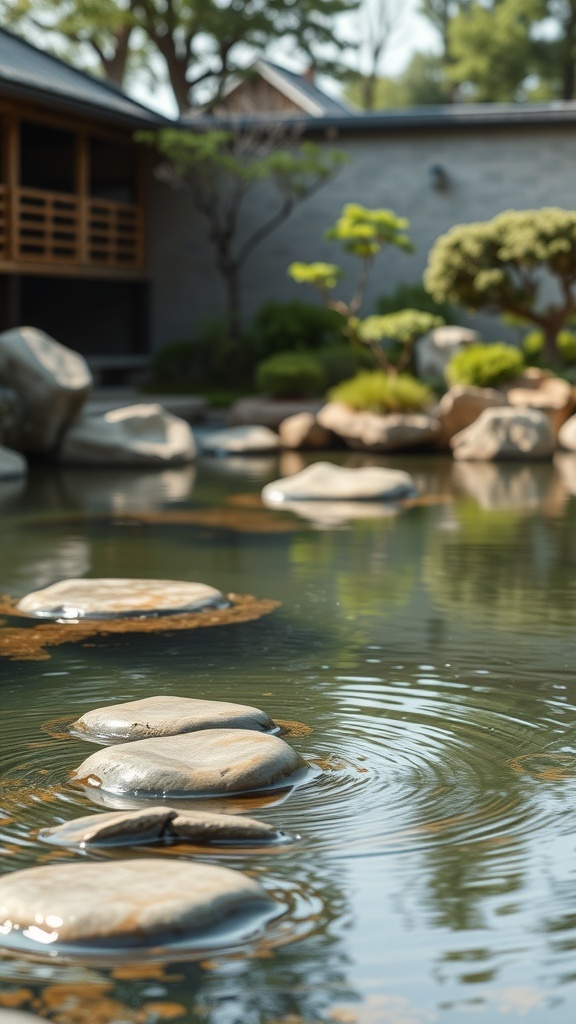
Water features can add a special touch to your zen garden. They create a sense of calm and tranquility. In the image, we see smooth stones leading across a serene pond. This setup invites you to walk across and enjoy the gentle ripples of the water.
Using stones like these not only enhances the visual appeal but also connects you to nature. The reflection of surrounding greenery in the water adds depth and beauty. You can even hear the soft sounds of water, which can be very soothing.
Consider adding a small fountain or a waterfall for a more dynamic feature. The sound of flowing water can be refreshing and can help drown out noise from the outside world. It’s all about creating a peaceful retreat where you can relax and unwind.
Choosing the Right Stones
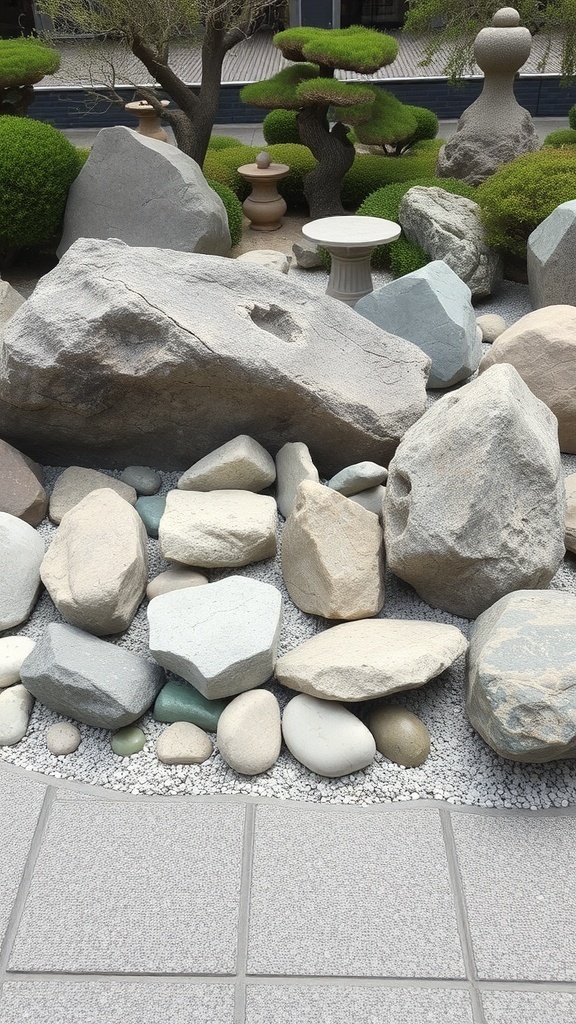
When designing a zen garden, selecting the right stones is key. The image shows a variety of stones, each with its own unique shape and color. These stones play a vital role in creating a peaceful atmosphere.
Large boulders can serve as focal points, while smaller pebbles fill in spaces and add texture. It’s essential to mix different sizes and colors to create visual interest. The smoothness of the stones can also contribute to the overall feel of the garden.
Think about how the stones will interact with the surrounding elements, like plants and water features. The right stones can enhance the natural beauty of your garden, making it a serene retreat.
Symbolism of Zen Garden Elements
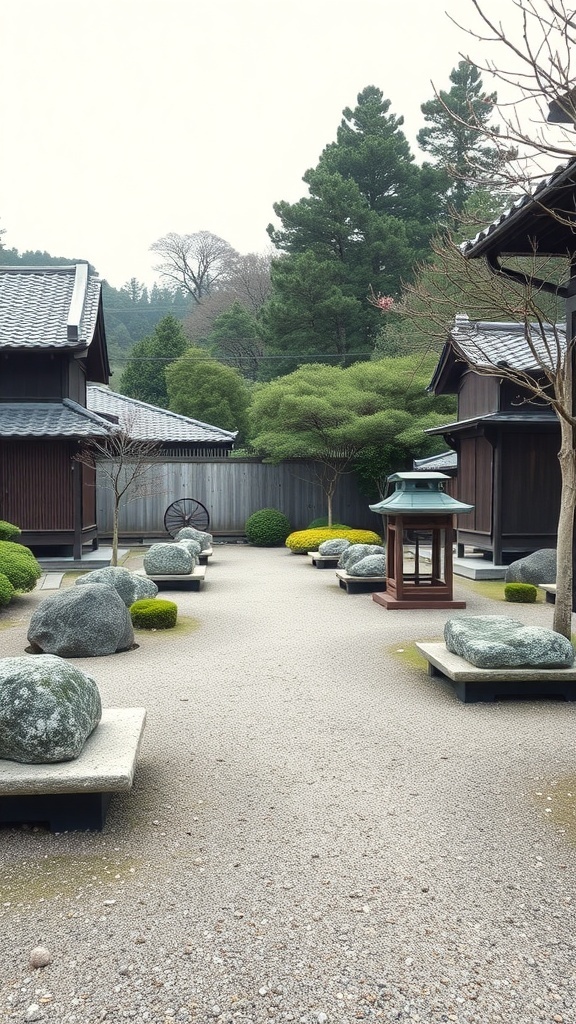
Zen gardens are more than just beautiful spaces; they are rich in symbolism. Each element serves a purpose and carries meaning. In the image, you can see a well-arranged garden with rocks, plants, and structures that create a serene atmosphere.
The rocks symbolize mountains or islands, representing stability and permanence. They are often placed thoughtfully to guide the eye and create a sense of balance. The smooth pebbles or gravel represent water, reflecting the calmness of a flowing stream. Raking patterns in the gravel can mimic waves, adding to the tranquil vibe.
Plants like the small bushes and trees in the garden symbolize life and growth. They bring color and texture, enhancing the overall harmony. The lantern, often seen in these gardens, represents enlightenment and the guiding light of wisdom.
Overall, each element in a Zen garden contributes to a peaceful environment, encouraging reflection and mindfulness. This space invites you to pause, breathe, and appreciate the beauty around you.
Creating Pathways for Meditation
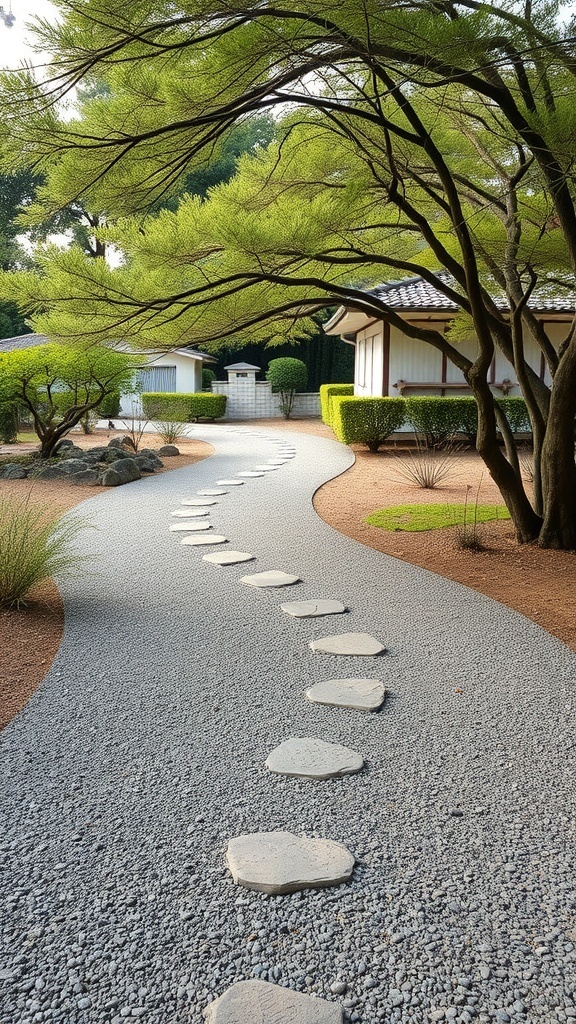
Pathways in a zen garden play a key role in guiding your thoughts and movements. The image shows a beautifully designed path made of stepping stones, leading through a serene landscape. This layout encourages a slow, mindful walk, perfect for meditation.
The gentle curves of the path invite exploration while keeping the experience calming. Each stone acts as a reminder to be present, allowing you to focus on each step. The surrounding greenery enhances this feeling, creating a natural frame for your journey.
Incorporating pathways like this can transform your garden into a peaceful retreat. They not only connect different areas but also create a sense of flow. Whether you’re walking alone or with a friend, these paths can deepen your connection to nature and to yourself.
Raked Patterns in Sand

Raked patterns in sand are a key feature of zen gardens. These designs create a sense of calm and order. The gentle lines and curves invite you to pause and reflect. Each stroke in the sand represents a moment of mindfulness.
The image shows beautifully raked sand, with smooth, flowing patterns. These designs can vary from simple straight lines to intricate swirls. The patterns often symbolize water ripples, connecting the garden to nature.
Creating these patterns is a meditative process. You can use a rake or even your hands to shape the sand. This practice encourages focus and tranquility. It’s a wonderful way to express creativity while enjoying the peacefulness of the garden.
When designing your own zen garden, think about the patterns you want to create. Each design can tell a story or evoke a feeling. The simplicity of raked sand allows for endless possibilities, making it a perfect canvas for your thoughts.
Elements of a Zen Garden
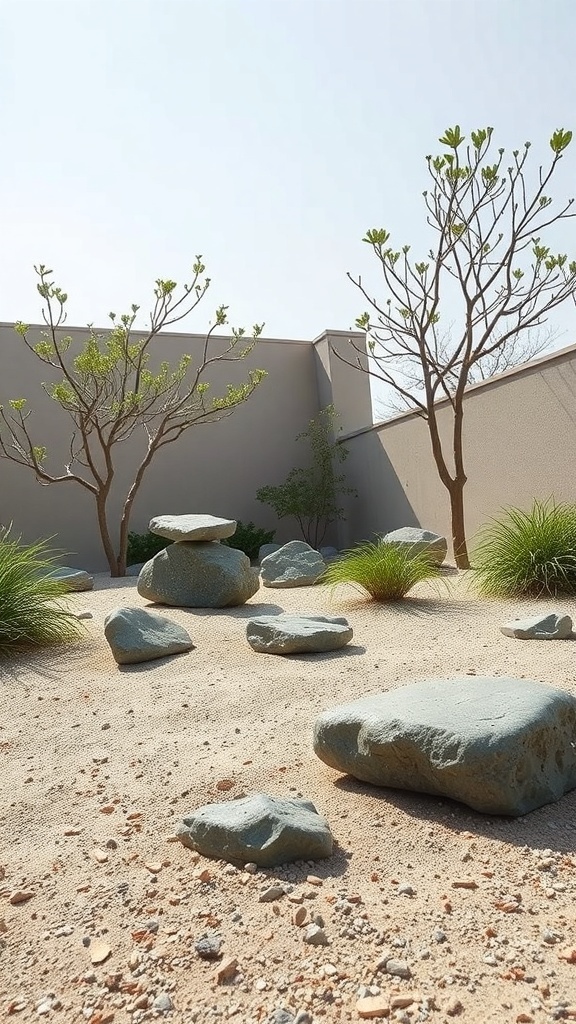
A Zen garden is a peaceful retreat that invites calm and reflection. The image showcases key elements that define this serene space. You can see carefully arranged rocks, which symbolize mountains or islands, creating a sense of balance.
The sandy ground represents water, often raked into patterns to mimic ripples. This adds a dynamic touch to the stillness of the garden. The sparse greenery, like the small trees and grass, brings life without overwhelming the simplicity of the design.
Each element in a Zen garden serves a purpose. The rocks and plants are placed thoughtfully to encourage meditation and mindfulness. This space is not just about aesthetics; it’s about creating a harmonious environment where one can connect with nature.
Incorporating these elements into your own garden can transform it into a tranquil escape. Whether you have a large yard or a small balcony, a Zen garden can be adapted to fit your space and needs.
Lighting for Evening Serenity
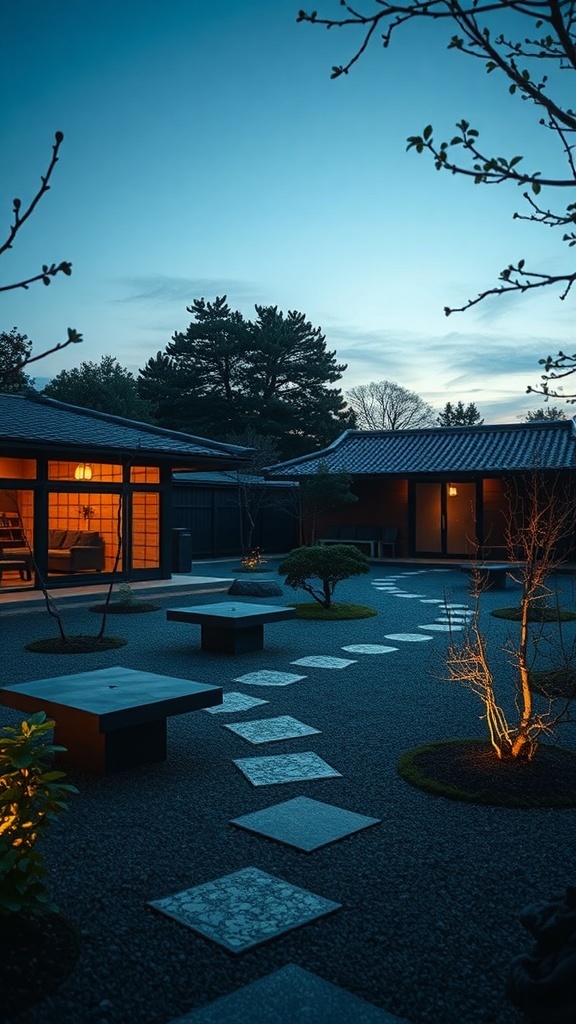
Creating a peaceful atmosphere in a zen garden during the evening is all about the right lighting. The image showcases a serene garden with soft, warm lights illuminating the path and surrounding plants. This gentle glow invites you to relax and enjoy the tranquility of the space.
The carefully placed lights highlight the stone path, guiding your way through the garden. The contrast between the darkening sky and the warm interior light from the house adds a cozy feel. It’s a perfect blend of nature and comfort, making it an ideal spot for evening reflection.
Incorporating low-level lighting, like lanterns or spotlights, can enhance the beauty of your garden while keeping the focus on the natural elements. This setup not only beautifies the space but also ensures safety while walking through the garden at night.
Selecting Plants for Tranquility
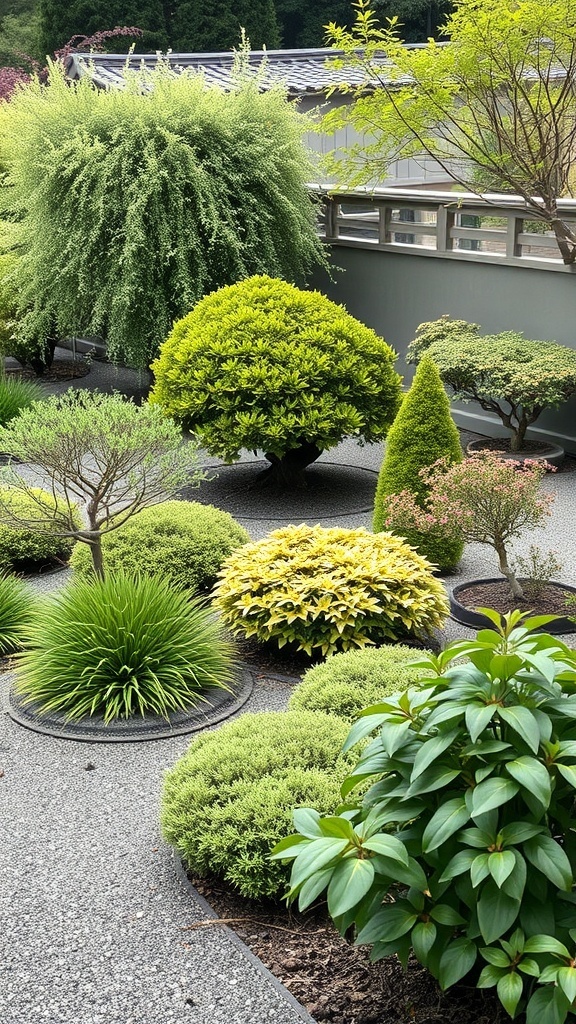
Creating a zen garden is all about finding the right plants that promote a sense of calm. In the image, you can see a variety of greenery, each contributing to a peaceful atmosphere. The round shapes of the shrubs and the soft textures of the plants invite relaxation.
When choosing plants, think about colors and forms. The vibrant greens in the image are soothing to the eyes. Incorporating different shades of green can create depth while maintaining a serene vibe. Plants like boxwoods and ferns are great options for a zen garden.
Consider the size and shape of the plants too. The rounded bushes in the picture provide a soft look, which is essential for tranquility. Smaller plants can be arranged to create layers, adding interest without overwhelming the space. This layering effect is seen in the image with the various heights and forms of the plants.
Don’t forget about texture! The contrast between smooth leaves and feathery grasses can enhance the garden’s peacefulness. The image shows a mix of textures that work harmoniously together. This variety can keep the garden visually appealing while still feeling calm.
Lastly, think about maintenance. Choose plants that fit your lifestyle. Some plants require more care than others. The goal is to create a space that feels effortless and serene, just like the garden in the image.
Seasonal Changes in a Zen Garden
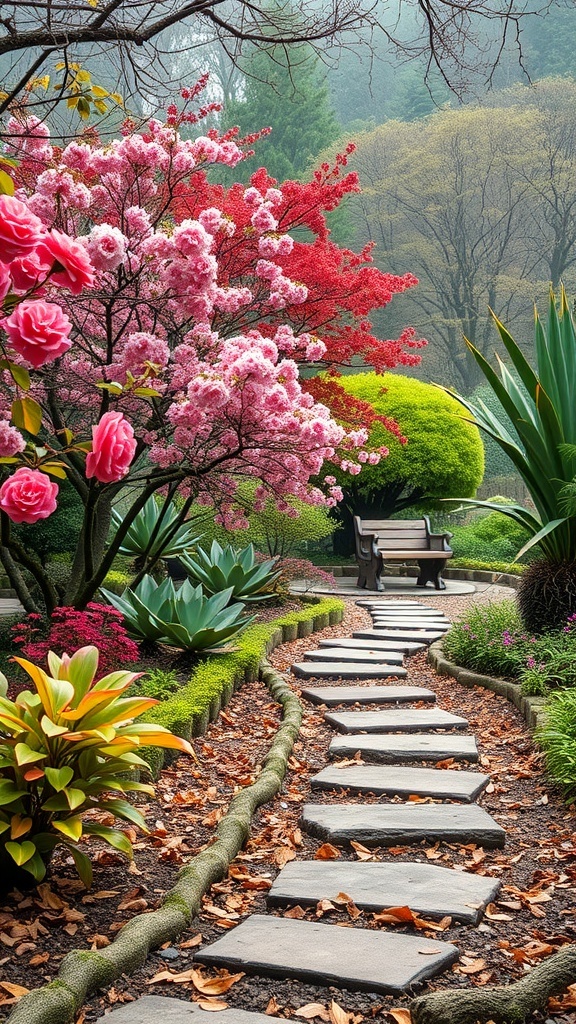
Zen gardens are a beautiful reflection of nature’s cycles. In spring, vibrant flowers like cherry blossoms and azaleas bloom, filling the space with color and life. The soft pinks and reds create a stunning contrast against the lush greenery.
As the seasons shift, the garden transforms. Summer brings a rich tapestry of greens, while autumn showcases warm hues of orange and yellow. The fallen leaves add texture to the pathways, inviting visitors to stroll and reflect.
Winter offers a serene beauty, with bare branches and a quiet stillness. Each season brings its own charm, making a Zen garden a place of peace and contemplation year-round. No matter the time of year, the garden invites you to pause and enjoy the moment.
Maintaining a Zen Garden
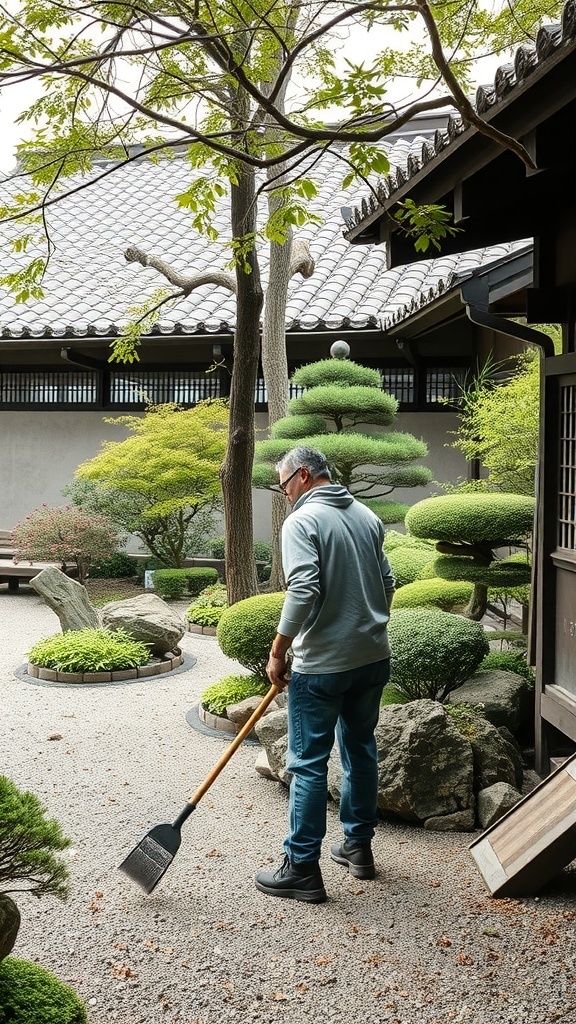
A Zen garden is a peaceful retreat that requires regular care to keep its beauty intact. In the image, we see a person tending to a garden, raking gravel and ensuring everything looks just right. This simple act is a key part of maintaining a Zen garden.
Raking the gravel creates patterns that symbolize water ripples. It’s a meditative practice that helps you connect with nature. Regular upkeep, like removing leaves and debris, keeps the space serene and inviting.
Pruning plants is another important task. Keeping shrubs and trees well-trimmed helps maintain the garden’s shape and flow. This not only enhances the visual appeal but also promotes healthy growth.
Watering is essential too. While Zen gardens often focus on dry landscapes, the plants still need hydration. A balanced approach to watering ensures that the greenery thrives without overwhelming the gravel areas.
Lastly, take time to enjoy your garden. Spend moments reflecting in the space you’ve nurtured. This connection is what makes a Zen garden truly special.
